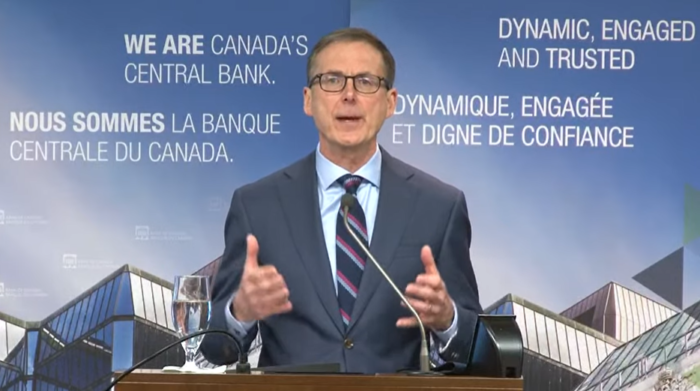In brief
- Today’s Announcement: No change to rates
- Overnight rate: 0.25%
- Prime Rate: 2.45% (also no change; see Prime Rate)
- Market Rate Forecast: No BoC hikes until first-half 2022
- BoC’s Headline Quote: “While economic prospects have improved, the Governing Council judges that the recovery continues to require extraordinary monetary policy support.”
- BoC on the Economy: “GDP growth in the first quarter of 2021 is now expected to be positive, rather than the contraction forecast in January.”
- BoC’s Full Statement: Click here
- Next Rate Meeting: April 21, 2021
The Spy’s Take
The market is pricing in boom times ahead. You know what that means. Higher growth expectations mean higher inflation expectations and a greater probability of rate increases—sooner than many expect.
RBC’s CEO put it like this:
“We see inflationary pressure building earlier than later…We do see…central banks having to respond to this in 2022, the latter half of 2022, with rate increases. Versus where you might have thought – late 2023, even 2024 – six months ago.”
Source: The Globe and Mail
It’s clear the BoC is behind the curve. It admitted today, “GDP growth in the first quarter of 2021 is now expected to be positive, rather than the contraction [we] forecast in January” (i.e., six weeks ago).
The Bank largely attributed the surge in bond yields, which have boosted 5-year fixed mortgage rates 20-30 bps in recent weeks, to “the improved U.S. growth outlook.”
The Bank also repeated that it “will continue its [bond buying] program until the recovery is well underway.” But so far this year, those purchases have not kept yields, and fixed mortgage rates, from rocketing higher. The Bank made little attempt to talk down bond yields today. That seemingly lowers the probability it will engage in some kind of yield curve control to cap borrowing costs.
How to play it
The only thing that’s certain is that nothing is certain. Risks to the rate outlook abound.
“The spread of more transmissible variants of the virus poses the largest downside risk to activity,” the Bank said. Moreover, Canada’s unemployment rate is still above the peak of the last two recessions.
There is record-breaking government stimulus, of course, but some of the more downbeat analysts, like David Rosenberg, claim stimulus will just be “transitory,” giving us a few quarters of strong growth and that’s it.
All this said, borrowers who want to play the odds listen to the market. It’s where real people bet real money on future rates, using all available information. And the market, however fallible, now implies that two years from today, we’ll see Canada’s prime lending rate 50-75 basis points higher (i.e., 2-3 BoC hikes). Bond traders are pricing in 125 bps in hikes by 2024.
That kind of monetary tightening is nothing to panic over. Heck, it would be historically modest if that’s all we got coming out of recession. But if you model out these forecasts, it does confirm one thing: the lowest nationally available uninsured 5-year fixed (at 1.89%) should outperform a variable (at prime – 1.16%) over the next five years — if those forecasts prove true. That assumes you either choose a fair penalty lender or do not change (i.e., break or refinance) your mortgage early.
If you’ve already got a deep-discount variable like prime – 1.00%, you’re financially stable and risk tolerant, and you have no plans to lock in, you’ll likely enjoy at least another year of a near-record-low prime rate. Maybe 2+ years if you’re lucky.

 log in
log in

6 Comments
How many years would HSBC Variable (.99%) be favoured over the current 5 year insured rate ?
Hi Cal,
Great question given we only touched on uninsured rates in our simulation.
If you’re in a province where you can get 1.42%, an insured 5yr fixed from a fair penalty lender still has the edge given the same assumptions.
But if you have to pay the lowest nationally available insured rate of 1.69%, the edge shifts back to that 0.99% rate from HSBC — contingent on no more than 5 quarter-point rate hikes (a somewhat risky assumption).
I’m willing to wager that the Canada 10yr bond yield will average 1.4% between March 2024 and February 2026 within a 0.1% margin of error.
Any takers?
I think you’ll find ample liquidity in the bond market for the trade, Ralph. And if you don’t, let me know and I’ll take the other side.
If I have a rate hold of 1.54% for 5 year uninsured mortgage, am I better taking this rate or going for a 5 year variable at 1.29% ?
Rob, that’s a brilliant observation. Time to put some numbers into the bond ETF screener. VCIT is starting to look attractive…